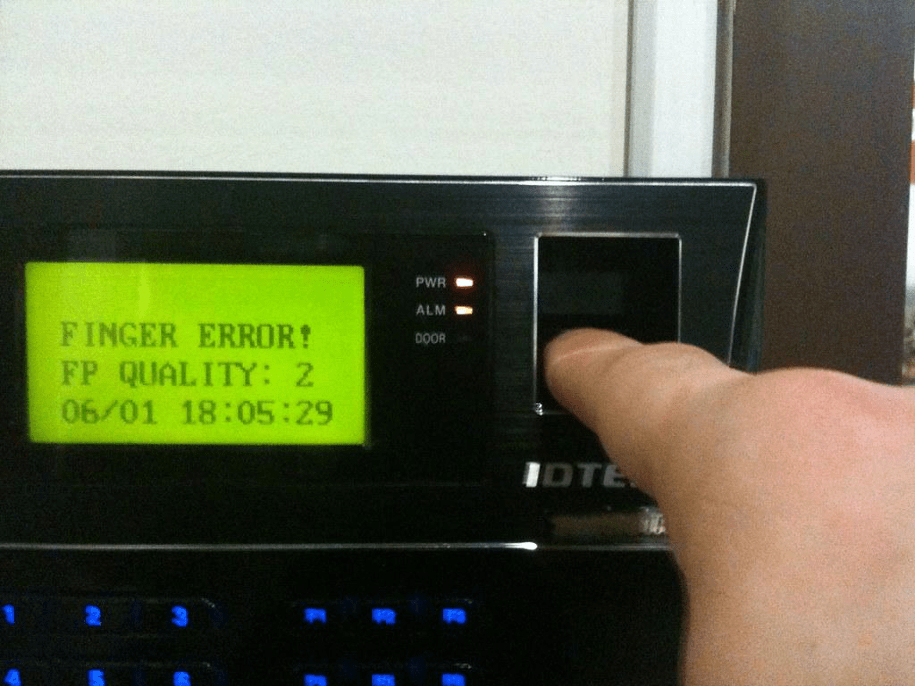Rachel Matthew, Applied Sciences, Fall 2020
Figure: A home security system which scans the homeowner’s fingerprint to verify their identity
Source: Flickr
In the modern day, fingerprint and facial recognition softwares have become relatively mundane, accessible from the mobile phones people carry everywhere they go. However, other security mechanisms, such as retinal scanners or sensors which read one’s DNA, are common only within the realm of spy movies and science fiction. One group of researchers at New York University are working to develop an entirely novel method of biometric authentication: verifying one’s identity through the 3-dimensional shape of the veins in their finger (“3D biometric,” 2020).
Biometric authentication is a method of identifying a known individual through unique features of their physical anatomy, most often for the purpose of security authentication. Biometric authentication has increasingly replaced traditional passwords as they are more difficult to fabricate; a sequence of numbers can theoretically be learned by anyone, but relatively few people have the necessary materials to replicate a biological fingerprint (“3D biometric,” 2020). As hardware continues to improve, allowing for increasingly high processing power in increasingly small and manageable devices, biometric authentication methods will likely become increasingly prevalent. As image-based methods, they require much more data than a combination lock or password, allowing for more security. However, for the intended user, the data they require is always, quite literally in this case, “on hand.”
This 3D finger vein biometric authentication method, in particular, was crafted to be near-impossible to replicate because it requires a unique anatomical feature to match in not only two but three different dimensions. Dr. Jun Xia, the research team leader, is confident in its specificity and exclusivity, believing that the only method of faking it would be to manufacture an “exact 3D replica of a person’s finger veins”, something which is “basically not possible” (“3D biometric,” 2020). Members of the team believe that the method could eventually be applied in smartphones, but for now the imaging equipment required for the method to function constrains its practical usage to higher-security facilities, like banks and military bases (“3D biometric,” 2020).
The imaging equipment they used, just like the authentication method itself, is currently at the height of technology and research. It combines light and sound, utilizing a methodology known as photoacoustic tomography (PAT). In the development of the 3D finger vein technology, the researchers used machines designed uniquely for their purpose (“3D biometric,” 2020). However, the method of PAT they used is more general.
PAT begins with a light source that generates photoacoustic (PA) waves. The sample absorbs these waves, gaining their energy, and experiences a slight rise in temperature as a result. With the increase in temperature comes an increase in pressure, originating where the initial PA wave was absorbed and propagating outwards in the form of a secondary PA wave. A transducer array positioned around the sample records these secondary waves, and computational algorithms use the data it collects to create a model of the imaged sample. To form a model in 3D as the New York team did, the light source targets multiple locations, eventually illuminating the entire sample, and a curved array of ultrasonic transducers picks up the reflected PA waves. In imaging vasculature specifically, hemoglobin plays a key role as an endogenous contrast agent (Zhou et al., 2016). Hemoglobin is both naturally-occurring in veins and provides high contrast when imaged. Higher contrast aids clarity and ultimately leads to higher-quality images.
3D imaging is not the only application of PAT. By combining both light and sound into its imaging process, PAT shares the benefits of both purely acoustic and purely optical imaging. It provides images with high spatial resolution even in deep tissues, as sound scatters less than light in biological tissue, and it can provide information on various physiological parameters, such as the saturation and metabolic rate of oxygen in blood. The sensitivity of PAT improves upon that of usual pure optical techniques by around two orders of magnitude (Zhou et al., 2016). Scientists have used the advantages of PAT to image the brains of living small animals in response to stimuli, to guide surgeries—the removal of specific tissues for biopsies important in cancer diagnosis, for example—for improved accuracy, and to measure parameters related to blood such as the rate of flow, width of vessels, and oxygen saturation in hemoglobin (Zhou et al., 2016).
No one invented photoacoustic technology specifically for the sake of identifying anatomy in biometric authentication, nor did anyone decide to use anatomy as an identity verification method because of the desire to create more applications for PAT. Each technology develops for many reasons in its own niche of fields, with PAT being largely biomedical and biometrics being security-based and algorithmic, yet their combination in the 3D finger vein authentication method has yielded specificity, security, and accuracy—responding correctly in 99% of tested cases (“3D biometric,” 2020).
References
- The Optical Society. (2020, September 28). 3D biometric authentication based on finger veins almost impossible to fool: Combining light and sound adds depth information that boosts security of biometric authentication. ScienceDaily. Retrieved October 26, 2020 from www.sciencedaily.com/releases/2020/09/200928152850.htm
- Zhou, Y., Yao, J., & Wang, L. V. (2016). Tutorial on photoacoustic tomography. Journal of biomedical optics, 21(6), 61007. https://doi.org/10.1117/1.JBO.21.6.061007


Leave a Reply